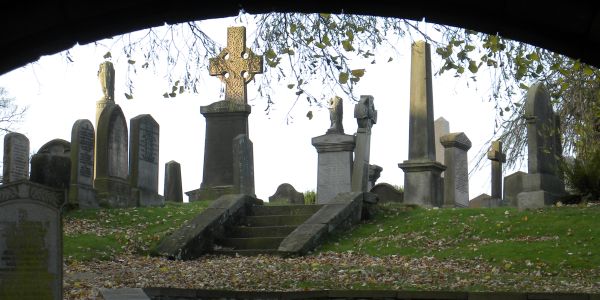
I love cemeteries. Aye, really. Before you think I’m daft or the least bit morbid, here’s why I’m keen on kirkyards, like the one above, viewed through the sixteenth-century remains of Mar’s Wark, built in Stirling by the Earl of Mar.
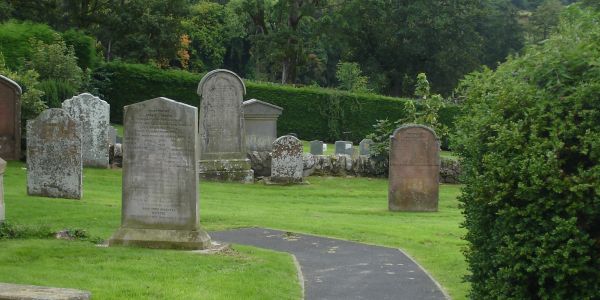
The grounds are green, the air quiet, the mood contemplative. On any weekday you’d be hard pressed to find a more peaceful spot than this kirkyard in Selkirk. (Interesting how the path comes to a dead end.)
The residents don’t make a sound. Even visitors keep their voices low. No one is sitting around with a Starbucks in one hand and an iPhone in the other, loudly chatting away—not in a kirkyard.
It’s a good place to think, breathe, and get a clearer perspective on life. The saying, “Every day above ground is a good one,” takes on new meaning in such a spot.
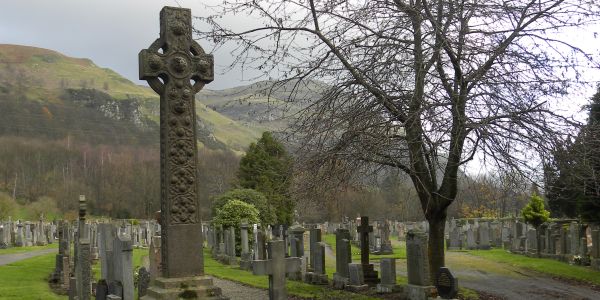
Rural parish churches often are surrounded by natural beauty. Logie is one of the oldest parishes (twelfth century) in Scotland, with the heather-covered Ochil Hills as a backdrop. The curve of the road is pleasing to the eye, the abundance of crosses comforting to the heart.
Other than the occasional bird on the wing, nothing moves when you lift your camera to capture so timeless a scene.
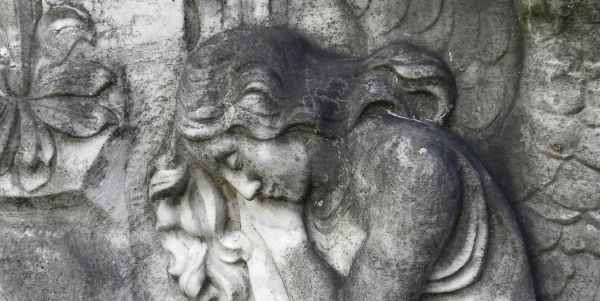
Look closer and you’ll see artistic expression abounds. Some stones are decorated with flowers and vines, others feature winged heads or beautifully carved figures. Even the elements can’t diminish an artist’s careful renderings or a family’s thoughtful investment. To think of being loved and mourned so deeply!
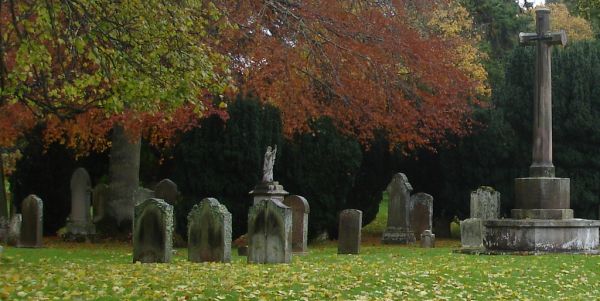
History is everywhere, especially in a place like Dryburgh Abbey in the Borders. For those of us who revel in such details, the inscriptions on the stones show us how long people lived, whom they married and when, how many children they had, what they did for a living, and what mattered most to them in this world and the next.
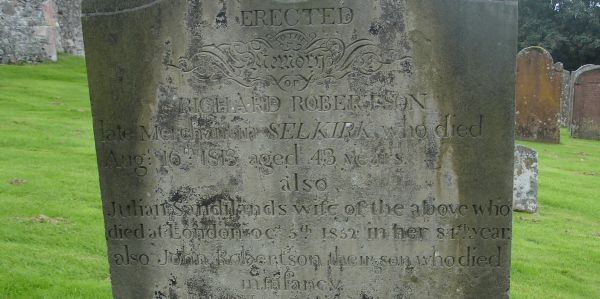
Epitaphs make fascinating reading. Some are sobering, others amusing, still more are informative, and the best ones point beyond the grave.
Consider these lines etched in memory of a seventeenth-century minister from Kirkoswald in Ayr:
“For praised be God, grace never quat him,
In life nor death, till glory gat him.”
Between archaic spellings and the use of Scots words, such epitaphs can be tricky to sort out, but we get the gist of this one: God’s grace never quits. It’s a gift from the One “who loved us and by his grace gave us eternal encouragement and good hope” (2 Thessalonians 2:16). When the end came for this minister of old, glory claimed him.
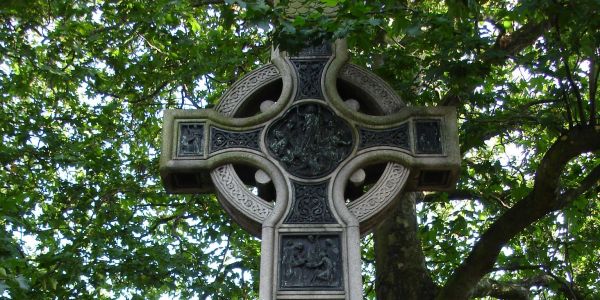
The greenery that encircles this Celtic cross in Edinburgh speaks more of life than of death. When I leave behind the silent stones and grassy paths to step back into the land of the living, I always do so with a grateful heart and a renewed longing for a far more beautiful place called Eternity.

 Subscribe to the blog via RSS
Subscribe to the blog via RSS
Lovely blog, Liz. Serene and tranquil.
Great to find a resting place with no cell phones or Starbucks!
Aye, it’s the peacefulness that appeals to me most, Lynn. And a timeless sort of beauty.
Beautiful pictures- simply stunning the designs…
So glad you enjoyed the photos, Kari. I never want to infringe on people’s privacy, so if relatives are visiting the graves, I put my camera away. Truth is, though, most of the time I’m the only living soul there!
Liz,
You’re a lass after me own heart. I LOVE graveyards for the exact same reason. Not the scary stuff, not the morbid stuff, but the stuff STORIES are made of.
Beautiful pics – felt like I was walking along with you!
Blessings,
Becky
So nice to have your company, Becky! Yes, stories EVERYWHERE.
I grew up near an old church and its graveyards. I still love to walk from my parents’ house to the churchyard and admire the monuments and in the older of the cemeteries, the odd shaped stones used as markers.
I agree, Elizabeth. The older the graveyard and its stones, the better!
As I walk along with you I am thinking of the men, women and children who have walked this world before us. I try to imagine what their lives were like and mourn for those who died so young and had no chance to impact our world. Most graveyards are not like the ones that I visited in Louisiana where the above ground tombs are so fascinating. The bones are removed after a time and reburied. Like you said so well, I too am waiting for the glory of eternity.
Louisiana graveyards are legendary, especially around New Orleans. HUGE tombs! Yes, it can be very disheartening to see the graves of infants and children. Makes me extra grateful for my own healthy children, and increases my compassion for those parents who are bearing a very heavy burden indeed. Thanks for sharing, Becky!
I love your photographs, Liz. They always invite me in and tell a story.
How different the caring for the old kirkyard you visited from the old cemeteries I visited recently with toppled stones and trees and grass and brambles grown wild. No paths to walk and I wonder how long it had been since living souls had been there and read the names and wondered or cared. I hope that God’s glory claimed them.
Thank you.
What a sad state of affairs, Elaine. On a Sunday afternoon in Scotland you’ll often find caring folk with scrub brushes and clippers scrubbing the gravestone of a loved one and trimming the grass. In our rush to get on with life we often don’t pause to honor those who’ve gone to glory before us. May we be found faithful, here and there. Bless you for your comment.
Dear Liz, I have no claim to Scottish blood, but this made me smile as I think back to a Sunday afternoon last May when we went to a large cemetery with shovel and brush and clippers and basket to literally unearth a stone long unknown to us. Next time, I’ll feel kindred to the Scots to do so!
A few years ago, I met a distant relative of my husband while doing family research. As he lived near the old “home place” and we loved the drive to that part of our state, we arranged to meet him. He took us to several cemeteries and told us how as he found old family tombstones, he had them re-carved so that those of us who came behind could find them. Amazing gratitude for those who came before.
I too love cemeteries – from my childhood when my mother and I would visit local ones to look for old tombstones. I find them a peaceful place and often visit them.
I’m SO glad I’m not the only one, Angela! It’s not a subject one generally brings up in conversation. “So, have you seen any good graveyards lately…?” ;>)
Lov going along with you to visit these graveyards–every chance I get I go locally. So peacefull and quiet and a good place to reflect on our own mortallity.
Quite so, Reeda! Some of them are as beautiful as any park. Cave Hill Cemetery here in Louisville, KY is exquisite: http://www.cavehillcemetery.com/ Created during the Victorian era, it has winding paths, lakes and ponds, and trees from all over the world. Lovely.
Cemetaries are my favorite places to walk around. I love the older stones also. The pictures that you show actually look similar to the countryside where I walk, in Vermont. Beautiful!
Oh, Vermont! What a splendid place to call home. I have fond memories of my visit there, many years ago. No place like it, especially in the autumn months.
Ohh how I LOVE cemetaries!!!! Everyone thinks I’m a little weird when I share that info. I love the history!!!!! I like to walk by the stones and wonder what kind of life each one led. They all have different stories to tell. Did they have a joyful life or did they endure hardships and struggles. I like to pray for their loved ones still here. I pray they know over savior and his amazing grace!!!
Not to worry about being a little weird, Diana. I am as well, and it appears we have lots of company. Each of us finds something meaningful in those quiet places.
I’m a amateur genealogist so wandering through cemeteries is second nature to me. You get to recognize who carved tombstones by their shape and the stone used. Taking photos of stones as you wander sometimes attracts a questioning glance but that’s okay. Most of my people were fisherfolk coming from a town that lost its entire fleet in 1805 with the majority of their menfolk, followed by numerous other fishing disasters. Life was had and could be extremely fleeting as the memorial room in the Lossiemouth Fisheries Museum is a testement to.
How fascinating, Lisa, that even the stones themselves and how they are carved speaks to you. And what a history your family has. For all of us who are curious about Lossiemouth in Moray, Scotland, lots of info here: http://en.wikipedia.org/wiki/Lossiemouth. Thanks for the comment.
My heart is in Scotland, right beside yours! My husband and I have wandered through many cemeteries during our visits in Scotland. We’d be driving along and see a tiny sign with the emblem for a cemetery and I’d suddenly say, “Turn here!” Those surprises were some of our best stops!
If you are ever in Colorado, try to go to the Rico cemetery right outside of the tiny town of Rico, which is near Telluride. Talk about a beautiful place, especially in autumn with the golden aspen leaves, high up in the mountains. It’s very well preserved, in a stunning location and a wonderful place to talk with God!
Hello Liz… I love all your blogs but this one I found so true to my own experiences. Also… I wanted to thank you for your books which I am starting to enjoy. I couldn’t put them down. The twin set.. Here burns my Candle… and Mine is the night. I felt as though I really knew and loved these characters and felt their pain and their joys. I’m waiting on my next order… God Bless you.
I loved reading this about Scotland. I am scottish through and through and have never visited a hotel, let alone a B & B with such an extensive breakfast menu, more’s the pity. I went to thurso on holiday and stayed in a hotel there while travelling to the farthest reaches of scotland in 2013 and the breakfast consisted of cereal choice, toasts, orange juice, 1 fried tomoato, 1 sausage, a fried egg, 1 rasher of bacon. I thought this was a pathetic show of the north of Scotland for the english visitors we treated to the coach holiday tour near mind ourselves. Your take on Scotland is beautiful and very true but I am biased. Nice to see things from an antipodean perspective. Enjoyable reading and that’s what a Scottish breakfast SHOULD contain but, sadly, dosen;t always. Personally we have cereal and toast through the week and a FULL SCOTTISH BREAKFAST as described by you at the weekend when there is more time to enjoy it.
Taking my first trip to Scotland! How far is this from Edinburgh? Love your photos! Xo